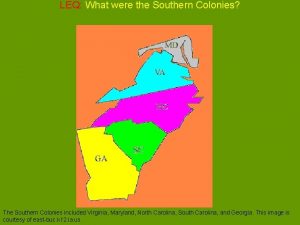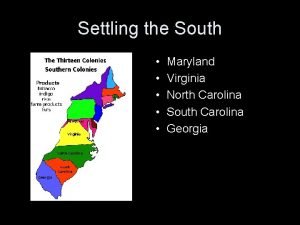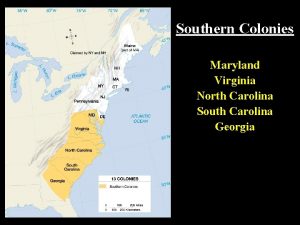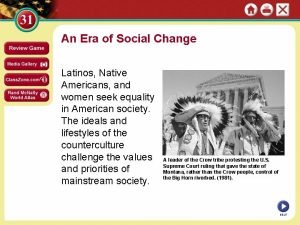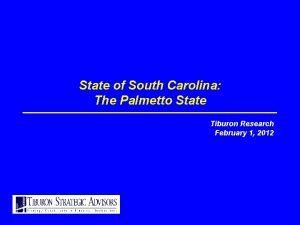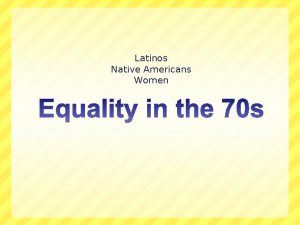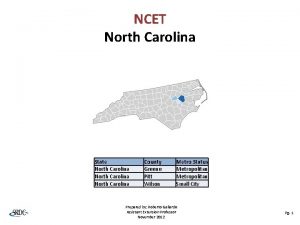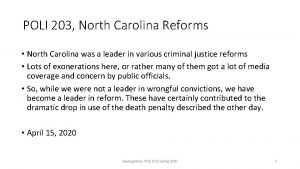THE NEW LATINO SOUTH LATINOS IN NORTH CAROLINA


















- Slides: 18

THE NEW LATINO SOUTH: LATINOS IN NORTH CAROLINA Understanding a Growing Community Axel Lluch – Governor’s Office of Hispanic/Latino Affairs 10/29/2020 1

THE NEW LATINO SOUTH n Latinos have differences & similarities in cultural & social customs, political, economic conditions and history n Most Latinos/Hispanics share a common language, Spanish. Yet there are more: Portuguese, indigenous and others n U. S. is a nation of immigrants: Europeans, Asians, Africans, Hispanics, etc… 10/29/2020 2

THE NEW LATINO SOUTH - Population Growth Pew Hispanic Center study –July 2005 n The Southeastern U. S. : highest population growth of Hispanics (1990 – 2000) : North Carolina - 492% Georgia - 300% South Carolina - 211% Alabama - 208% Fast-growing economies magnets for young, unmarried, mobile Latino immigrants; Post. Katrina impact n Economic growth in 1990’s created jobs for 410, 000 Hispanics and 1. 9 mi. non-Hispanic workers n Hispanic school-age population grew 322% in the South (‘ 90 -’ 00) vs. 10% & 18% for whites & blacks n 10/29/2020 3

THE NEW LATINO SOUTH - Population Growth § Hispanics nationwide increased from 22. 4 mi. to 44. 5 mi. (1990 -2007). Now largest ethnic group in U. S. - 15. 1% of t. population (US Census– 7/ 07) n Hispanics in NC had a 492% increase from 77, 000 to 379, 000 (1990 -2000); 4. 7% of NC population (U. S. Census- 2000) n NC Hispanic population increased 68. 5% (‘ 00’ 07) totaling 638, 444; 7% of state population (Census 7/07) 10/29/2020 4

THE NEW LATINO SOUTH - Population Growth n Hispanics have highest fertility rates of all ethnic/ race groups: 2. 9 vs. 2. 0 and 1. 8 children/ woman (vs. U. S. & white aver. – Census 2000) n 55% of U. S. Hispanics are 2 nd. & 3 rd. generation native born U. S. citizens ( 3/04 - Pew Hisp. Center ) n In 2004, 55% of NC Hispanics were citizens or legal residents and 45% were unauthorized residents (UNC-CH Economic Study 2006) 10/29/2020 5

THE NEW LATINO SOUTH - Immigrants n Hispanic heritage has been part of our nation: California, Texas, N. Mexico, Utah, Nevada, Arizona & Wyoming were part of Mexico until 1845 -48; Florida claimed by Spain in 1500’s n Puerto Rico is a U. S. territory since 1898 n There are numerous generations of Hispanic. Americans as well as foreign-born Latinos n We also have a high number of unauthorized immigrant Latinos 10/29/2020 6

THE NEW LATINO SOUTH - Immigrants n They are predominantly from Mexico, but come from all Latin American countries n They also are migrating from other U. S. states n Initial rural migration of low education now includes also urban / more educated immigrants n More permanent migration & family reunification process occurring; less circular migration 10/29/2020 7

% Hispanics by Nationality: Total U. S. North Carolina 2000 Census Data 10/29/2020 8

THE NEW LATINO SOUTH–Social norms n Slight differences in social / cultural traditions n Strong community, family ties and faith values n More expressive / open emotions ( touch, less personal space) n Less eye contact, avoid confrontation n Importance of building trust & relationships n Flexible time management / less structured n Varies with integration process, social interaction 10/29/2020 9

THE NEW LATINO SOUTH - Welfare/Health n Most immigrants, including Latinos, receive less welfare/social benefits than native-born citizens n Many immigrants are young / healthy - needing less health / welfare services; Median age 27. 4 yrs. vs. 36. 4 for US population (Census 7/06) n Barriers to healthcare access make low income Latinos under served and vulnerable population n Highest uninsured rates of any ethnic group. In 2003 CDC reported Hispanics with no health insurance coverage varied from 18 % to 38 % (P. Ricans-Mexicans). Medicaid coverage went from 19. 3 to 31 % (various - P. Ricans) 10/29/2020 10

THE NEW LATINO SOUTH - Education n From school years 2001 - 2005, Hispanic students accounted for 57% of total growth in NC public schools (UNC-Ch Economic Study) n NC Hispanics have lower education levels vs. non -Hispanics ( median 7. 5 vs. 12 yrs of school ); 50% of Hispanics completed less than 8 yrs. of schooling (UNC-Ch Economic Study) n Latino youth educated in the US don’t differ much in dropout rates vs. native born (Pew Hisp. Ctr. Jan 04) n Parental involvement is the strongest predictor for academic success of Latinos (Machado-Casas/Zuniga study 205) 10/29/2020 11

THE NEW LATINO SOUTH-NC Economic Impact ( UNC - CH SCHOOL OF BUSINESS STUDY – 2006 ) n NC Hispanics had estimated total after tax income of $8. 3 billion in 2004 ; 20% sent to Latin America, saved, or used for interest payments, the residual spending had total impact of $9. 2 billion on NC n $9. 2 billion impact to NC economy through purchases and tax payments, while net cost to state budget $61 million, $102 per Hispanic, for health care, education and corrections n NC exports to Latin America have increased from $2. 9 billion in 1999 to $4. 1 billion in 2004 10/29/2020 12

THE NEW LATINO SOUTH - Jobs n NC Hispanics are younger / healthier; 55. 3% are working-ages of 18 - 44 vs. 37. 3% non. Hispanics (UNC-CH Economic Study 2006) n Many Latinos work low-paying / high-risk jobs seldom pursued by non-immigrants; H 2 A guest workers: 8, 300 of 98, 000 total farm workers in NC (E. S. C. - 2005) n They fill jobs 76 million “baby boomers” (born 1946 - 64) are starting to leave & create new businesses (supply vs. demand) 10/29/2020 13

THE NEW LATINO SOUTH – Economy (Inter-Amer. Dev. Bank study 2006 ) § Most immigrants send money back to their countries, once they are well-established ($45 bi. /annual) § NC immigrants sent $1. 2 bi. to Latin America in 2006. ( $300/month aver. /hsld. ) § U. S. workers born in L. America had gross income of $465 bi. in 2006; 90% was spent locally n Studies show a net positive impact to the economy from their economic contributions. NC impact is $12. 3 bi. n Mexico is U. S. 2 nd. trading partner. U. S. – Mexico trading $290 bi. in 2005; US exports to Mexico grew $50 - $120 bi. since NAFTA (1994); CAFTA/DR approved in 2006 10/29/2020 14

THE NEW LATINO SOUTH - Challenges n Language n Limited education, high dropout rates n Post-high n Limited barriers in a global village school education access social contact and isolation n Immigration status of many foreignborn Latinos 10/29/2020 15

NEW LATINO SOUTH-Recommendations n Comp. Immigration Reform in post- 9/11 America n Learn English to broaden Hispanics progress n Education alternatives: part-time, after-work, online, Plazas Comunitarias, Learn & Earn, private scholarships, out-of-state education n Build relationships with non-Hispanics (social competence and integration) n Understand & embrace NC - US lifestyles and customs: a generational integration process n No “miracle or fast” solutions: a gradual process 10/29/2020 16

THE NEW LATINO SOUTH - Dilemmas n NC Growing vs. vanishing pains in transition to high-skilled economy ? n Latinos & Post-Katrina gulf region impact n “Browning” & “Aging” of America: diverse migration & retiring baby boomers in a Global Economy § Forces of nature: survival & family reunification § Balance of ecosystems: human nature will take its course 10/29/2020 17

CONTACT INFORMATION: Axel Lluch Office of Hispanic/Latino Affairs NC Office of the Governor 919 -733 -5361 or 800 -662 -7952 Axel. Lluch@ncmail. net Cary. Delaosa@ncmail. net THANK YOU !!! 10/29/2020 18
 North carolina marschland
North carolina marschland What is this image
What is this image Maryland virginia north and south carolina and georgia
Maryland virginia north and south carolina and georgia Virginia, maryland, north carolina, south carolina, georgia
Virginia, maryland, north carolina, south carolina, georgia Lesson 1 the industrial north
Lesson 1 the industrial north Old south vs new south streetcar named desire
Old south vs new south streetcar named desire Shams al ma'arif
Shams al ma'arif Bajo la misma luna where to watch
Bajo la misma luna where to watch Latinos and native americans seek equality
Latinos and native americans seek equality South carolina state firefighters association
South carolina state firefighters association Iaai palmetto
Iaai palmetto South carolina rivers and lakes
South carolina rivers and lakes Sc wh-1605
Sc wh-1605 Types of turtles in sc
Types of turtles in sc South carolina the beautiful palmetto state
South carolina the beautiful palmetto state Sc enterprise information system
Sc enterprise information system South carolina fall line
South carolina fall line What is north carolina state bird
What is north carolina state bird Nc state fruit
Nc state fruit

